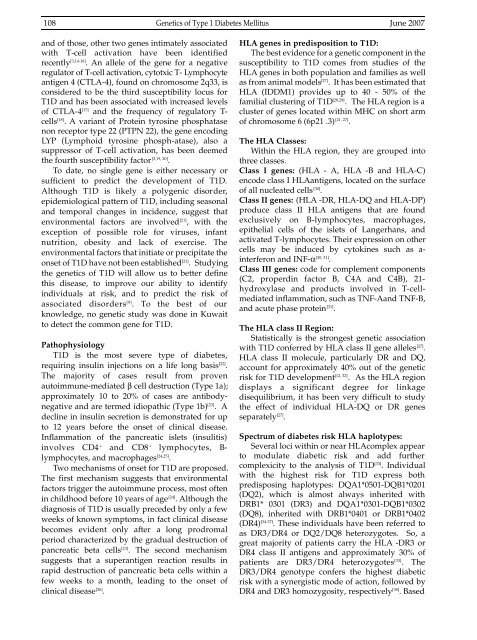Vol 39 # 2 June 2007 - Kma.org.kw
Vol 39 # 2 June 2007 - Kma.org.kw
Vol 39 # 2 June 2007 - Kma.org.kw
- No tags were found...
Create successful ePaper yourself
Turn your PDF publications into a flip-book with our unique Google optimized e-Paper software.
108Genetics of Type 1 Diabetes Mellitus <strong>June</strong> <strong>2007</strong>and of those, other two genes intimately associatedwith T-cell activation have been identifiedrecently [3,14-16] . An allele of the gene for a negativeregulator of T-cell activation, cytotxic T- Ly m p h o c y t eantigen 4 (CTLA-4), found on chromosome 2q33, isconsidered to be the third susceptibility locus forT1D and has been associated with increased levelsof CTLA-4 [17] and the frequency of regulatory T-cells [18] . A variant of Protein tyrosine phosphatasenon receptor type 22 (PTPN 22), the gene encodingLY P ( Lymphoid tyrosine phosph-atase), also asuppressor of T-cell activation, has been deemedthe fourth susceptibility factor [3,19, 20] .To date, no single gene is either necessary ors u fficient to predict the development of T1D.Although T1D is likely a polygenic disord e r,epidemiological pattern of T1D, including seasonaland temporal changes in incidence, suggest thate n v i ronmental factors are involved [ 2 1 ] , with theexception of possible role for viruses, infantnutrition, obesity and lack of exercise. Theenvironmental factors that initiate or precipitate theonset of T1D have not been established [21] . Studyingthe genetics of T1D will allow us to better definethis disease, to improve our ability to identifyindividuals at risk, and to predict the risk ofassociated disord e r s [ 9 ] . To the best of ourknowledge, no genetic study was done in Kuwaitto detect the common gene for T1D.PathophysiologyT1D is the most severe type of diabetes,requiring insulin injections on a life long basis [22] .The majority of cases result from pro v e nautoimmune-mediated β cell destruction (Type 1a);approximately 10 to 20% of cases are antibodynegativeand are termed idiopathic (Type 1b) [23] . Adecline in insulin secretion is demonstrated for upto 12 years before the onset of clinical disease.Inflammation of the pancreatic islets (insulitis)involves CD4 + and CD8 + lymphocytes, B-lymphocytes, and macrophages [24,25] .Two mechanisms of onset for T1D are proposed.The first mechanism suggests that environmentalfactors trigger the autoimmune process, most oftenin childhood before 10 years of age [24] . Although thediagnosis of T1D is usually preceded by only a fewweeks of known symptoms, in fact clinical diseasebecomes evident only after a long pro d ro m a lperiod characterized by the gradual destruction ofp a n c reatic beta cells [ 23 ] . The second mechanismsuggests that a superantigen reaction results inrapid destruction of pancreatic beta cells within afew weeks to a month, leading to the onset ofclinical disease [26] .HLA genes in predisposition to T1D:The best evidence for a genetic component in thesusceptibility to T1D comes from studies of theHLA genes in both population and families as wellas from animal models [27] . It has been estimated thatHLA (IDDM1) provides up to 40 - 50% of thefamilial clustering of T1D [28,29] . The HLA region is acluster of genes located within MHC on short armof chromosome 6 (6p21 .3) [21, 27] .The HLA Classes:Within the HLA region, they are grouped intothree classes.Class I genes: (HLA - A, HLA -B and HLA-C)encode class I HLAantigens, located on the surfaceof all nucleated cells [30] .Class II genes: (HLA -DR, HLA-DQ and HLA-DP)p roduce class II HLA antigens that are foundexclusively on B-lymphocytes, macro p h a g e s ,epithelial cells of the islets of Langerhans, andactivated T-lymphocytes. Their expression on othercells may be induced by cytokines such as a-interferon and INF-α [30, 31] .Class III genes: code for complement components(C2, pro p e rdin factor B, C4A and C4B), 21-h y d roxylase and products involved in T- c e l l -mediated inflammation, such as TNF-Aand TNF-B,and acute phase protein [31] .The HLA class II Region:Statistically is the strongest genetic associationwith T1D conferred by HLA class II gene alleles [27] .HLA class II molecule, particularly DR and DQ,account for approximately 40% out of the geneticrisk for T1D development [12, 32] . As the HLA regiondisplays a significant degree for linkagedisequilibrium, it has been very difficult to studythe effect of individual HLA-DQ or DR genesseparately [27] .Spectrum of diabetes risk HLA haplotypes:Several loci within or near HLAcomplex appearto modulate diabetic risk and add furthercomplexicity to the analysis of T1D [33] . Individualwith the highest risk for T1D express bothpredisposing haplotypes: DQA1*0501-DQB1*0201(DQ2), which is almost always inherited withDRB1* 0301 (DR3) and DQA1*0301-DQB1*0302(DQ8), inherited with DRB1*0401 or DRB1*0402(DR4) [34-37] . These individuals have been referred toas DR3/DR4 or DQ2/DQ8 heterozygotes. So, agreat majority of patients carry the HLA -DR3 orDR4 class II antigens and approximately 30% ofpatients are DR3/DR4 hetero z y g o t e s [ 3 3 ] . TheDR3/DR4 genotype confers the highest diabeticrisk with a synergistic mode of action, followed byDR4 and DR3 homozygosity, respectively [38] . Based
















